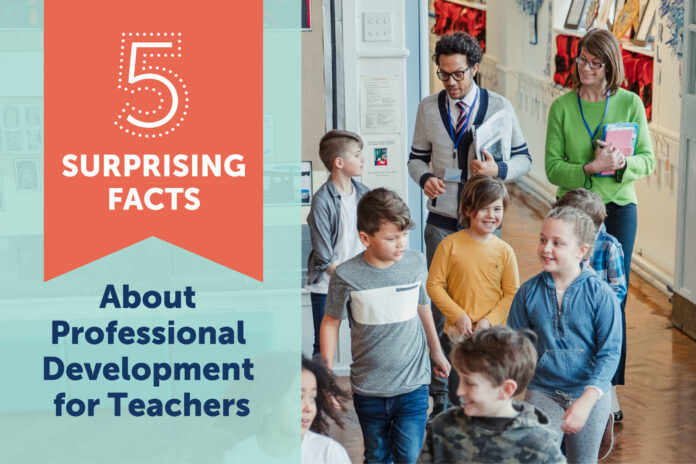There’s no denying the impact of professional development on educators across the country. Schools spend $18 billion on PD annually, and educators spend anywhere from 68 to 89 hours a year in PD trainings. Yet, studies continue to find that most teachers are not satisfied with their PD and, moreover, that PD often fails to accomplish what it sets out to do.
Given these trends and statistics, Advancement Courses recently published a report, Professional Development for Teachers: What Schools Value and How They Invest, to find out about funding sources, how PD is conducted, and the challenges schools face in finding satisfying PD. Here are some of its key findings.
1. Larger districts spend less money on PD per educator than smaller districts.
The size of a school or district makes a big difference in how much they’re spending on PD. Larger districts tend to spend far less per educator than smaller districts. This is likely because large districts can take cost-saving measures not available to smaller ones. For example, larger districts likely have more resources to develop PD internally or negotiate group rates for better prices from outside vendors.
2. Funding often comes with strings attached.
OK, maybe this one isn’t so surprising. Eighty-three percent of school leaders cite price as the top deciding factor when choosing teachers’ PD. However, the price tag of PD is only a small part of the conversation surrounding funding.
The source of funding has a big impact on how school leaders spend their budgets. For example, schools that receive little to no government funding tend to have lower-than-average budgets; however, they seem to have more flexibility in their choice of PD opportunities. When schools receive most of their funding from the government, 82 percent of their PD is dictated by district plans and 58 percent by state plans, compared to 57 and 29 percent , respectively, for schools without government funding.
3. Technology education is the most popular topic for PD.
School leaders choose a wide variety of topics for PD, including classroom management, safety, testing, diversity, special education, and specific content areas. However, a common theme emerged: At every grade level, at the school and district level, and whether or not teachers were involved in choosing topics, technology was school leaders’ top choice for PD. The need for technology PD might include both pedagogy (how to instruct students in technology) and professional training (preparing teachers to use new technology).
4. Despite time constraints and higher rates of satisfaction with online PD, most teachers’ PD takes place in person, at the school.
When asked about the biggest challenge to offering PD, school leaders’ top response, more than double the next-most popular response, was not having enough time. In a multiple-response question, 74 percent of school leaders said PD takes place on district-wide days off (e.g., teacher in-service days), and more than half said teachers also complete PD on their own time or when school isn’t in session.
Only 30 percent of schools use mostly online PD. The interesting thing about these schools is that school leaders express higher rates of satisfaction, they’re able to offer more options and flexibility for PD, and teachers are more likely to take PD for personal gain (not just to fulfill pre-existing requirements).
5. Teachers don’t get to choose their PD opportunities nearly as often as school leaders would like.
Teachers’ satisfaction with PD rises in direct proportion with the amount of say they have in their PD experiences. However, a mere 7 percent of teachers choose whether they participate in PD in the first place; the rest do so because of school, district, or state mandates.
Eighty percent of school leaders want to provide teacher choice or customization, but in reality, only 24 percent of schools are able to do so. This finding is understandable, however, considering what we know about funding source requirements, and the fact that more than 70 percent of school leaders said they also have to consider factors such as school/district continuous improvement plans, tracking PD outcomes, and peer interactions.
For more information on these findings and more, you can download the full report for free on the Advancement Courses website. You can also check out Advancement Courses’ presentation at ASCD Empower20 (Sunday, March 15 at 1:45 p.m.) and visit us at booth #824.
About Advancement Courses
For more than 30 years, Advancement Courses, a Wiley brand, has been a leader in professional development, providing expertly crafted, classroom-applicable courses to thousands of teachers across the country. With more than 240 online courses in 20 different subject areas in our catalog, Advancement Courses creates customizable PD plans for schools and districts so they can offer training in the topics that matter most to them, including ESSA requirements, district/school improvement plans, teacher wellness and retention, and much more. All courses are graduate level, online, and self-paced to allow for maximum flexibility and no disruption to classroom time.
About the author
Krysia Lazarewicz is a long-term veteran of the education industry. She began her career as a math and science teacher in various school settings, including parochial, rural, public urban, and independent boarding schools. Krysia left teaching in 2010 to focus on pedagogical training and online curriculum development for both higher education faculty and K–12 professional development.
Krysia formerly led the Advancement Courses business, focusing on the teaching experience and teacher retention through quality professional development. She is passionate about supporting educators and helping school systems find long-term, sustainable solutions to help teaching become a career-long choice for amazing educators.








